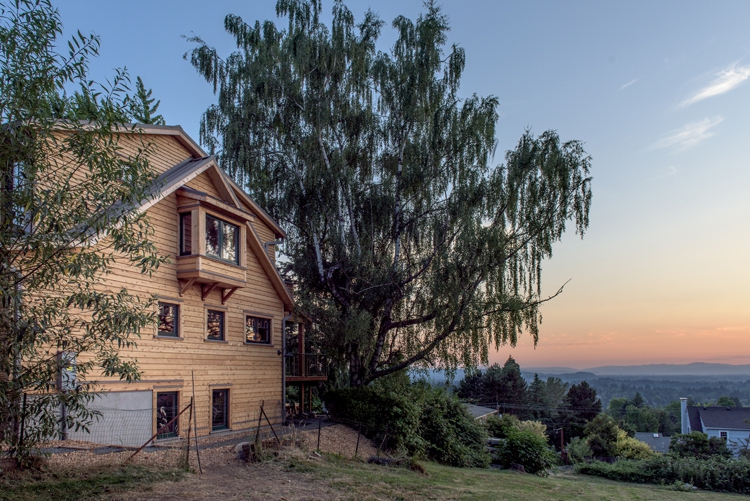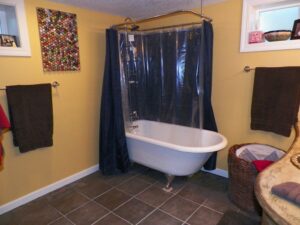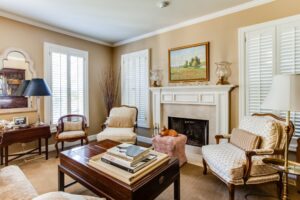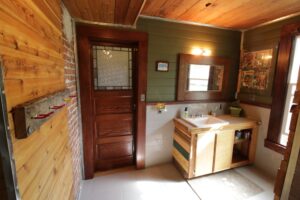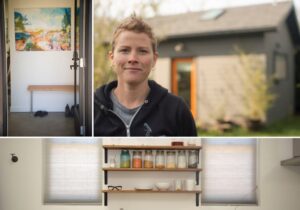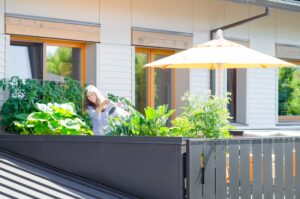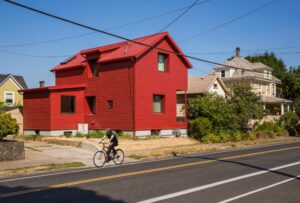Photos by Bob Zaikoski | Birdsmouth Construction
Sunset falls over the Willamette Valley, and the home built by Birdsmouth Construction has a beautiful view and an ecological purpose with tight-knot cedar siding that is intended to fade to gray—negating the need for stain, paint or maintenance. metal roofing has a longer lifespan than asphalt roofing and can be recycled when it’s time to be replaced.
Imagine an old-growth forest or a watershed, where all the different parts of an ecosystem work together to keep it healthy and thriving.
If constructed mindfully, a home can function in much the same way. The key is understanding what Mother Nature has always known: that respecting and playing on the strengths of each part of the system will yield the best results.
Lisa and Magnus Carlsson were already aware of this when they started planning their own haven in Southwest Portland. They pictured a home that was comfortable, was quiet and had great indoor air quality. They also wanted a house that would last for a long time and lower their energy usage significantly.
That immediately got Josh Salinger of Birdsmouth Construction thinking about how to use building science to maximize the home’s potential. The firm specializes in what Salinger calls high-performance building. “It’s a better way to build,” he says. “If you take the right materials and install them correctly, you get all these positive side effects. You get very little energy usage. You get really high levels of occupant comfort.”
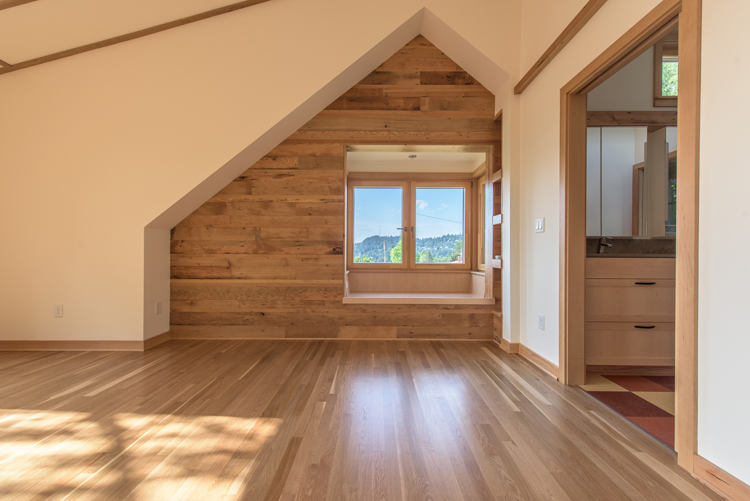
The master bedroom accent wall was created using remilled studs from the original home.
Salinger knows a thing or two about ecosystems, both the built and natural kind. He holds degrees in zoology and biological aspects of conservation from the University of Wisconsin-Madison and has been passionate about conservation issues ever since.
After graduating, he took several temporary jobs, including some home-remodeling projects. “Eventually, those jobs turned into larger and larger projects,” he says.
That’s when he decided to start his own construction company. “Especially with the advent of the green-building movement, I was able to take my values and combine that with my love of building things and create a business out of that,” he says.
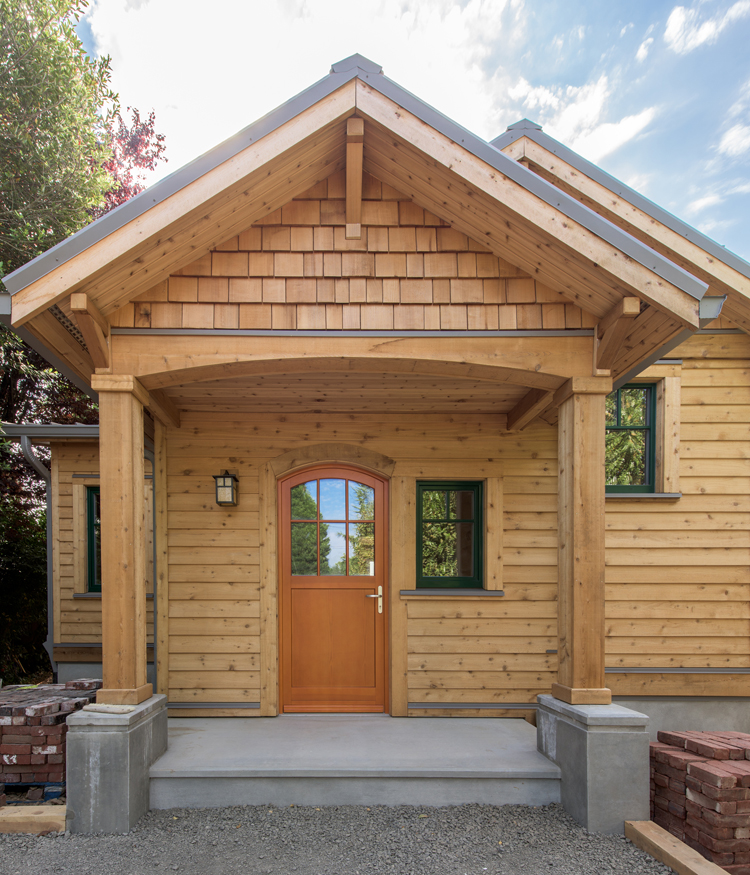
The front gable is a welcoming entrance to the house.
The Carlssons hired Birdsmouth because their vision matched so well with the couple’s. Once the plans were drafted by R&B Design Studio, the team began working through the building science behind constructing the 2,800-square-foot home. They modeled different ideas using software intended to determine a home’s energy usage. They discussed what would happen to the home’s energy usage, comfort and air quality if they tweaked items such as the insulation, windows or ventilation systems.
“You realize real quickly you can’t just do one of these things,” Salinger says. “They’re all part of a system that has to be considered holistically in a home.”
When they were ready to begin building, their first step was to remove a derelict 1925 bungalow that was already on the lot. Rather than tearing the whole thing down, Birdsmouth deconstructed the house and salvaged what they could.
“We took down old chimneys and used the bricks for pavers,” Salinger says. “All the wood studs and beams got remilled and used back in the house. The old oak floors were repurposed for railings and ceiling details. Anything that could be reused or recycled was.”
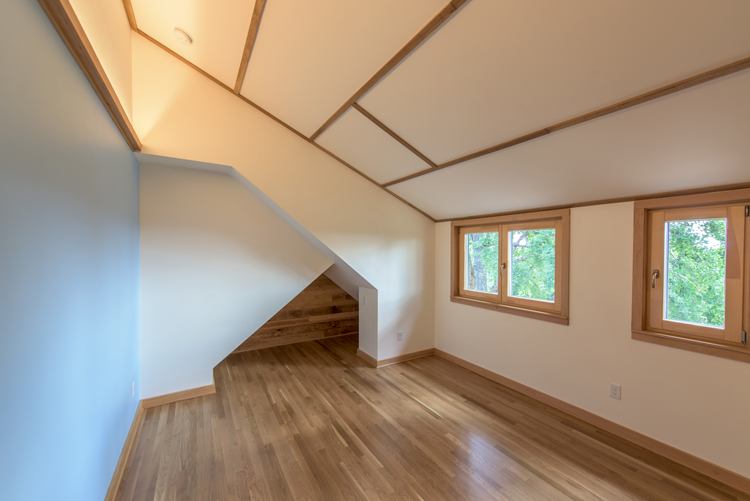
The kids bedroom with a nook for playing and exploring.
They poured a new foundation and built the four-bedroom, two-and-a-half-bathroom house on top. The whole thing, including the slab and foundation, has some type of insulation. Salinger describes this as making the entire home “thermally isolated” so there is no place energy can get lost.
Features like a continuous air barrier and European triple-pane windows make the house virtually air-tight. But that can lead to problems if not addressed, Salinger says. If air and the moisture it carries has no way to leave, the house can begin to feel stale. Mold and mildew can grow, which degrades the structure and adversely affects indoor air quality.
One of Salinger’s solutions was to put a super-efficient heat recovery ventilator in the house. The device is continually providing fresh air and exchanges the entire volume of air in the house roughly once every three hours. Any heat from the indoor air is transferred to the fresh incoming air so that no energy is lost. “They basically have fresh outdoor air that’s been tempered and filtered in their house at all times,” he says. Besides providing continuous fresh, comfortable air for the occupants, the device helps manage interior moisture levels.
Birdsmouth also installed a two-inch layer of cork insulation to the outside of the sheathing. The reason for this is to keep the inside of the sheathing from becoming a place for condensation to occur. The cork insulates this critical area and keeps it warm enough to be outside of the dewpoint. This mitigates any potential for building degradation from mold growth or rot. Along with cork being a natural, renewable resource, it sequesters more carbon during its life cycle than it takes to harvest, transport and install, thus making it a carbon-negative building material. Another great property of cork is that it makes a great sound insulator, an important goal for the Carlssons.
The Carlsson’s house is third-party-certified as a net-zero-energy home by Earth Advantage. This means it produces all (or even more) of the energy it needs over the course of a year. Not only do homes built with this strategy require solar panels or other alternative-energy sources, they need to use very little energy. All the appliances are Energy Star-certified, including an induction range and ventless dryer. The home has 100 percent LED lighting throughout. Heating and cooling is provided by a ducted mini split-heat pump.
“We’ve taken the heating and cooling loads of this house and reduced them by roughly 90 percent,” Salinger says. “The energy required to heat and cool it is roughly equivalent to the amount of energy it takes to run a hair dryer.”
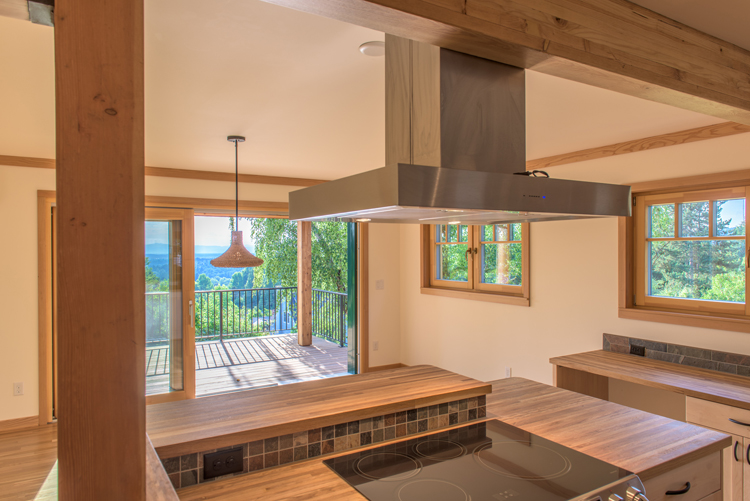
The induction range and island look out over the three panel lift slide door that accesses the deck.
Nearly all the wood details inside the house, from the mosaics on the walls to the accents in the bathrooms, are made with recycled materials. Where they had to purchase new wood — for example, the butcher-block kitchen counters and the extensive decks off the back of the house — Birdsmouth used FSC-certified products.
As the Carlssons begin moving into their new home, they do so knowing it will stand as long as an old-growth Douglas fir. Salinger and his team plan to continue monitoring the house for many years to make sure it really is performing the way they expected.
“That will help us determine if there’s anything else we can do better next time,” he says.



